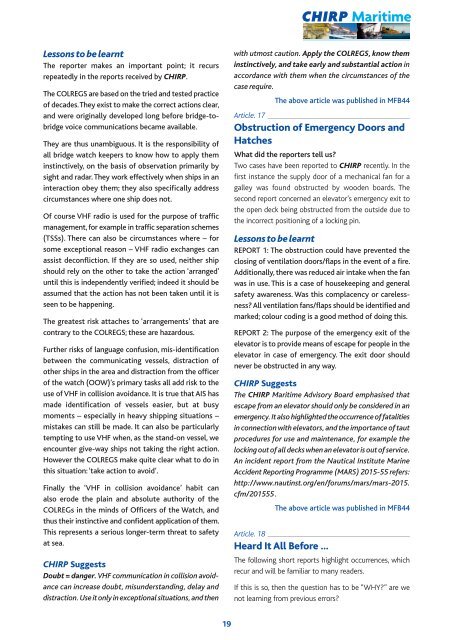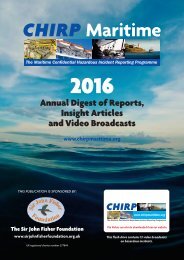CHIRP annual digest 2016 flip
Create successful ePaper yourself
Turn your PDF publications into a flip-book with our unique Google optimized e-Paper software.
<strong>CHIRP</strong> Maritime<br />
Lessons to be learnt<br />
The reporter makes an important point; it recurs<br />
repeatedly in the reports received by <strong>CHIRP</strong>.<br />
The COLREGS are based on the tried and tested practice<br />
of decades. They exist to make the correct actions clear,<br />
and were originally developed long before bridge-tobridge<br />
voice communications became available.<br />
They are thus unambiguous. It is the responsibility of<br />
all bridge watch keepers to know how to apply them<br />
instinctively, on the basis of observation primarily by<br />
sight and radar. They work effectively when ships in an<br />
interaction obey them; they also specifically address<br />
circumstances where one ship does not.<br />
Of course VHF radio is used for the purpose of traffic<br />
management, for example in traffic separation schemes<br />
(TSSs). There can also be circumstances where – for<br />
some exceptional reason – VHF radio exchanges can<br />
assist deconfliction. If they are so used, neither ship<br />
should rely on the other to take the action ‘arranged’<br />
until this is independently verified; indeed it should be<br />
assumed that the action has not been taken until it is<br />
seen to be happening.<br />
The greatest risk attaches to ‘arrangements’ that are<br />
contrary to the COLREGS; these are hazardous.<br />
Further risks of language confusion, mis-identification<br />
between the communicating vessels, distraction of<br />
other ships in the area and distraction from the officer<br />
of the watch (OOW)’s primary tasks all add risk to the<br />
use of VHF in collision avoidance. It is true that AIS has<br />
made identification of vessels easier, but at busy<br />
moments – especially in heavy shipping situations –<br />
mistakes can still be made. It can also be particularly<br />
tempting to use VHF when, as the stand-on vessel, we<br />
encounter give-way ships not taking the right action.<br />
However the COLREGS make quite clear what to do in<br />
this situation: ‘take action to avoid’.<br />
Finally the ‘VHF in collision avoidance’ habit can<br />
also erode the plain and absolute authority of the<br />
COLREGs in the minds of Officers of the Watch, and<br />
thus their instinctive and confident application of them.<br />
This represents a serious longer-term threat to safety<br />
at sea.<br />
<strong>CHIRP</strong> Suggests<br />
Doubt = danger. VHF communication in collision avoid -<br />
ance can increase doubt, misunderstanding, delay and<br />
distrac tion. Use it only in exceptional situations, and then<br />
with utmost caution. Apply the COLREGS, know them<br />
in stinctively, and take early and substantial action in<br />
accordance with them when the circumstances of the<br />
case require.<br />
The above article was published in MFB44<br />
Article. 17<br />
Obstruction of Emergency Doors and<br />
Hatches<br />
What did the reporters tell us?<br />
Two cases have been reported to <strong>CHIRP</strong> recently. In the<br />
first instance the supply door of a mechanical fan for a<br />
galley was found obstructed by wooden boards. The<br />
second report concerned an elevator’s emergency exit to<br />
the open deck being obstructed from the outside due to<br />
the incorrect positioning of a locking pin.<br />
Lessons to be learnt<br />
REPORT 1: The obstruction could have prevented the<br />
closing of ventilation doors/flaps in the event of a fire.<br />
Additionally, there was reduced air intake when the fan<br />
was in use. This is a case of housekeeping and general<br />
safety awareness. Was this complacency or careless -<br />
ness? All ventilation fans/flaps should be identified and<br />
marked; colour coding is a good method of doing this.<br />
REPORT 2: The purpose of the emergency exit of the<br />
elevator is to provide means of escape for people in the<br />
elevator in case of emergency. The exit door should<br />
never be obstructed in any way.<br />
<strong>CHIRP</strong> Suggests<br />
The <strong>CHIRP</strong> Maritime Advisory Board emphasised that<br />
escape from an elevator should only be considered in an<br />
emergency. It also highlighted the occurrence of fatalities<br />
in connection with elevators, and the importance of taut<br />
procedures for use and maintenance, for example the<br />
locking out of all decks when an elevator is out of service.<br />
An incident report from the Nautical Institute Marine<br />
Accident Reporting Programme (MARS) 2015-55 refers:<br />
http://www.nautinst.org/en/forums/mars/mars-2015.<br />
cfm/201555.<br />
The above article was published in MFB44<br />
Article. 18<br />
Heard It All Before …<br />
The following short reports highlight occurrences, which<br />
recur and will be familiar to many readers.<br />
If this is so, then the question has to be “WHY?” are we<br />
not learning from previous errors?<br />
19



